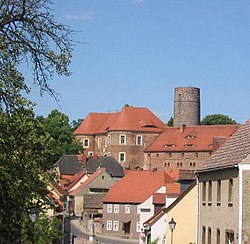Belzig
| Bad Belzig | ||
|---|---|---|

Old Town with Eisenhardt Castle
|
||
|
||
| Coordinates: 52°08′32″N 12°35′44″E / 52.14222°N 12.59556°ECoordinates: 52°08′32″N 12°35′44″E / 52.14222°N 12.59556°E | ||
| Country | Germany | |
| State | Brandenburg | |
| District | Potsdam-Mittelmark | |
| Government | ||
| • Mayor | Hannelore Klabunde | |
| Area | ||
| • Total | 234.82 km2 (90.66 sq mi) | |
| Elevation | 88 m (289 ft) | |
| Population (2015-12-31) | ||
| • Total | 11,120 | |
| • Density | 47/km2 (120/sq mi) | |
| Time zone | CET/CEST (UTC+1/+2) | |
| Postal codes | 14806 | |
| Dialling codes | 033841 | |
| Vehicle registration | PM | |
| Website | www.belzig.de | |
Bad Belzig (![]() ), also known as Belzig, is a historic town in Brandenburg, Germany located about 70 km (43 mi) southwest of Berlin. It is the capital of the Potsdam-Mittelmark district.
), also known as Belzig, is a historic town in Brandenburg, Germany located about 70 km (43 mi) southwest of Berlin. It is the capital of the Potsdam-Mittelmark district.
Bad Belzig is located within the Fläming hill range and in the centre of the High Fläming Nature Park. The plains north of the town are home to one of the few great bustard populations in Germany.
Since 2003, when 14 surrounding villages were incorporated into Bad Belzig, some of them voluntarily, others by Brandenburg Landtag (state parliament) legislation, Bad Belzig has an area of 234.83 km². These villages became districts (Ortsteile) of Belzig:
The forest of Verlorenwasser near Werbig encompassed the geographical centre of East Germany.
A Slavic fort of Belizi was first mentioned in a 997 deed issued by Emperor Otto III in favour of the Archbishopric of Magdeburg. Whether this denotation refers to Bad Belzig or the neighbouring town of Beelitz has not been conclusively established. Nevertheless both towns celebrated their 1000 years anniversary in 1997.
...
Wikipedia



